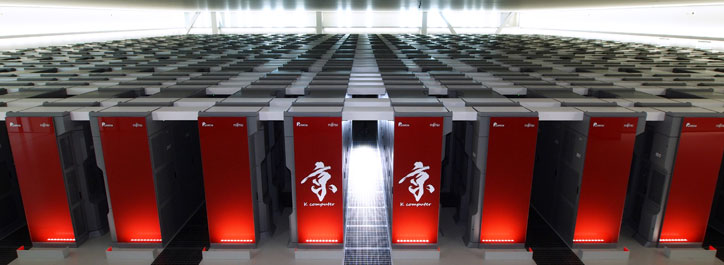
The computer room at RIKEN AICS has 864 racks. Each holds 24 system boards comprising four CPUs.
(Photo: Courtesy of RIKEN)
What if one machine could transport an astronomer to the most distant reaches of space or shrink a doctor to microscopic size to explore a human cell? What if this machine could combine and harness the power of more than 80,000 central processing units (CPUs)? This is not science fiction. This is the K computer, one of the world’s fastest supercomputers, in Kobe, Japan.
Synergy in Action
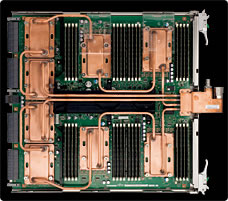
A system board with four CPUs concealed beneath a water cooling module. Four Interconnect Control chips at left connect CPUs on their boards with other system boards.
(Photo: Courtesy of Fujitsu)
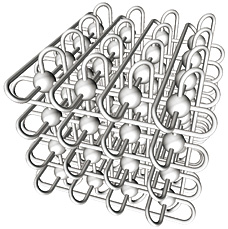
A graphical interpretation of the CPU network’s frame format. The spherical forms represent CPUs and the pipes are the networks. This design is known as Tofu (Torus Fusion) interconnect.
(Illustration: Courtesy of Fujitsu)
“If we take an ordinary laptop’s performance as the walking speed of a human being, the K computer’s performance would be the orbital speed of the International Space Station.”
This is how Dr. Akinori Yonezawa, deputy director of the RIKEN Advanced Institute for Computational Science (AICS), describes the K computer, which is one of Japan’s National Critical Technologies. The enormous computer, with 864 racks of processors, was completed on June 29, 2012, and operations began on September 28, 2012.
The K computer operates in the realm of petaflops. FLOPS, or floating point operations per second, is a measure of computer performance based on the number of fractional-number operations that can be done per second. There are megaflops (1 million FLOPS), gigaflops (1 billion) and teraflops (1 trillion). The K computer has achieved 10 petaflops — 10 quadrillion (1016). In fact, it got its name from the Japanese kei, which means “10 quadrillion.”
In order to perform as many calculations as the K computer does in one second, all 7 billion people on the Earth would have to spend 165 straight days solving one of the four basic arithmetical operations with 15- or 16-digit numbers, one every 10 seconds.
Coordination is what enables these staggering abilities; it is a true expression of strength in numbers. Dr. Yonezawa explains that the “design of the CPUs used in the K computer is based on those in the PCs we use every day. The K computer has 82,944 CPUs, arrayed, networked and wrapped into one system. The CPUs are constantly cooled by 15°C (59°F) purified water flowing through water-cooling modules made of copper, reducing their temperature from about 100°C (212°F) to 50°C (122°F) or so.” AICS developed the CPUs, reducing the relay distances for optimal performance and designing the network so it automatically detours “dead” units.
The K computer’s forte is numerical simulation — representing real-world or hypothetical scenarios in a computer program. This technique is invaluable to researchers because it allows them to stretch the limits of science and examine what would otherwise be impossible to imagine. “By building a digital model inside the computer,” Dr. Yonezawa says, “we can test phenomena in an experiment or observations that we cannot conduct in the real world because of danger, difficulty, cost, time or precision. We can also create conditions or aim for higher standards of precision that are not possible in reality.”
What Can 82,944 CPUs Achieve?
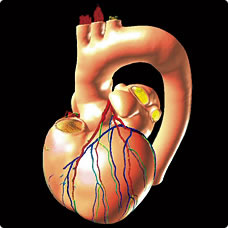
Research and development for the Next Generation Integrated Simulation of Living Matter is under way.
(Image: Courtesy of Hisada/Sugiura Laboratory, the University of Tokyo)
Dr. Yonezawa says the K computer was developed to give the best, most versatile performance in the widely used LINPACK Benchmarks for use across all fields of research. It has realized 93.2 percent of its theoretical maximum performance and has gained trust thanks to its highly consistent performance. Dr. Yonezawa expects “epoch-making discoveries and improvements, ranging from the infinitesimal world to astronomy.”
For example, the K computer uses numerical simulation to render the formation of galaxies in 3-D. It delves into the hearts of supernovas, revealing what happens inside exploding stars. Dr. Yonezawa says that such powerful experimentation permits researchers to “hypothesize about the formation of the universe by comparing actual observations with the simulation model.”
Scientists are also utilizing the K computer to analyze another heart — the human heart. By studying a molecular-level numerical model of the heart, doctors can collect data that they can use to improve diagnosis and therapy. “Cells in the heart contain proteins that determine how they function or the effects drugs will have on them,” Dr. Yonezawa explains. “We combine each component ― cells forming heart muscle, arteries and veins — to build a model of the heart, which appears on a screen as a living human heart.” Utilizing this model, doctors can observe how different medicines or chemical compounds affect proteins, such as those that control the expansion and contraction (i.e., pumping) of the heart muscle. “The simulation,” Dr. Yonezawa says, “can replace testing medicines on humans.”
There are plans to use the K computer's simulation capacity for more detailed and large-scale experiments, such as to create a model of a particular person’s heart. Dr. Yonezawa believes that this should not be too difficult for the K computer, using data from conventional diagnostic tools such as MRI scans. In addition to the life sciences, astronomy and astrophysics, research will be conducted in areas ranging from manufacturing (designing safer cars and developing products more quickly) and disaster prevention (predicting seismic waves and tsunami damage) to the environment (predicting climate change and the effects of El Niño) and nuclear power (analyzing power plants, developing fusion reactors).
The Power of Unity
“Unity is strength. When there is teamwork and collaboration, wonderful things can be achieved.”
A dragonfly. A telescope. A computer. These seemingly unrelated objects are elegant, if not unexpected, examples of what the young American poet Mattie Stepanek meant when he said the above words. They illustrate that when the many become one, surprise, inspiration and accomplishment follow. What innovations will collaboration yield in the future, and how will humans use them? Together, we are sure to find out.
-

Nikon Multi-Lens Projection System for Advanced LCDs
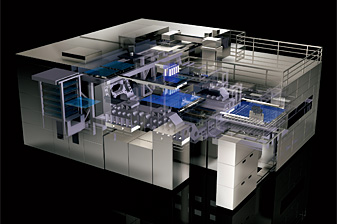
LCD Scanner: Frame Format Perspective ViewLiquid crystal displays (LCDs) are getting larger and increasing their image definition every year. Nikon is contributing to their evolution by improving product quality and manufacturing efficiency.
An LCD screen is a collection of dots called pixels. One pixel is composed of three colors (red, green and blue), each of which incorporates a switch that enables light to pass through it. So, a high-definition LCD television with 2 million screen pixels has 6 million switches. LCDs realize high-resolution pictures by controlling these switches.
LCD scanners project light onto a photomask, a thin glass plate with the original switch circuit pattern drawn on it. After passing through a lens, the light exposes the circuit patterns onto the glass plate. The bigger the LCD, the bigger the glass plate.
More effective production of modern LCDs requires the technology to project a larger circuit pattern in a single process and to cut as many panels as possible from a single glass plate. This, in turn, requires an increase in the size of lenses and scanners. However, it is not easy to make bigger lenses, and larger scanners can be difficult to maintain and demand more space for setup.
To overcome these challenges, Nikon developed its unique Multi-Lens Projection System, which employs two rows of lenses working in concert as one giant lens to effectively expose light on large glass plates. For example, the FX-101S LCD scanner, which corresponds to the approximately 3 x 3m (9.8 x 9.8-ft.)10th-generation large glass plates, has up to 14 lenses.
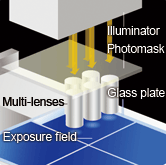
Multi-Lens Projection System (5-lens system)In recognition of realizing efficient production of large, high-quality glass plates, the five Nikon engineers who developed the Multi-Lens Projection System received in 2012 the Prime Minister’s Prize in the 4th Monodzukuri Nippon Grand Award, a Japanese government program that recognizes outstanding individuals working in the field of manufacturing.
This is only one example of Nikon’s tireless efforts to develop technologies that help make life more exciting and engaging.
- Products & Support – Precision Equipment
This page provides information on our IC/LCD steppers and scanners, machines integral to IC/LCD manufacturing.
- Products & Support – Precision Equipment
- 1. Insects: Eyes that See the World in a Different Way
- 2. Our “Super Vision” into the Universe
- 3. The K computer: A New Way of Looking at the World

